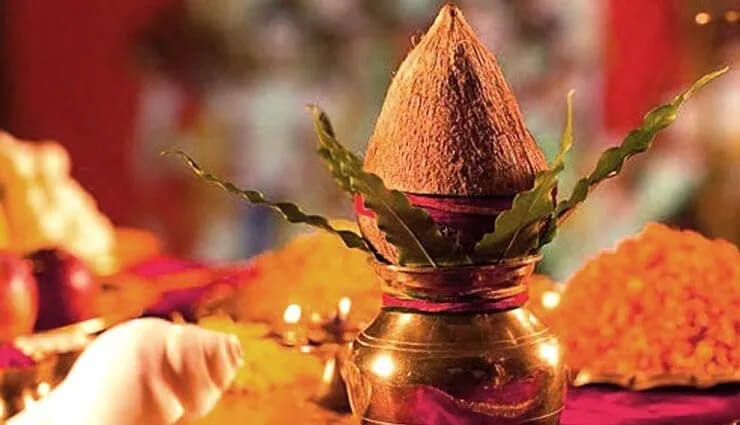Kalash Sthapna is a central element in one of the most revered Sadhana practices, especially during Navratri. It symbolizes the invocation of divine energies, specifically the worship of Maa Durga in Her various forms, over the course of nine days. The purpose of Kalash Sthapna is not only to offer prayers but also to prepare the devotee for spiritual elevation and connection with higher states of consciousness. Here’s a step-by-step explanation of the process, significance, and essential aspects of this sacred ritual.

### Preparations Before Kalash Sthapna
1. **Cleansing the Space**:
- Begin by selecting a clean and peaceful space in your home for the temple. The temple should ideally be positioned at eye level to maintain a respectful gaze during prayers.
- Cleanse and purify the space with Ganga Jal (holy water from the Ganges). Sprinkling Ganga Jal around the temple and worship area is believed to purify the space, removing any negative or stagnant energy.
- It is important to maintain cleanliness throughout the nine days. The purity of the space reflects the purity of your intention during this ritual.
2. **Positioning the Temple**:
- The temple or the altar where the Kalash will be placed should be in the **north-east direction**. In Vastu Shastra, the north-east direction is considered to be highly auspicious, as it represents divine energies.
---
### **Steps for Kalash Sthapna**
1. **Preparation of the Kalash (Sacred Vessel)**:
- **Kalash (Pot)**: Choose a Kalash made of mud or metal (traditionally copper or brass). This Kalash represents the source of creation and contains divine energy.
- **Mauli (Sacred Thread)**: Tie a red mauli (sacred thread) around the neck of the Kalash to symbolize the binding of spiritual energy within it.
2. **Filling the Kalash**:
- **Water**: Fill the Kalash with clean water up to the brim. Water is a symbol of life, purity, and abundance.
- **Sacred Items in Water**: Add a coin, turmeric, clove, cardamom, and another coin into the water. Each element holds spiritual significance:
- *Coin*: Symbolizes wealth and prosperity.
- *Turmeric*: Represents purity, auspiciousness, and protection from negative energies.
- *Clove and Cardamom*: Enhance the fragrance and energy of the water, representing the sweetness and sacredness of life.
3. **Adorning the Kalash with Flowers**:
- Place fresh flowers inside the Kalash, symbolizing beauty, devotion, and the offering of nature’s finest gifts to the Divine.
4. **Mango Leaves**:
- Place **five mango leaves** at the mouth of the Kalash. Before placing, add a small pinch of **haldi (turmeric)** and **kumkum (vermilion)** to the leaves, symbolizing the welcoming of divine feminine energy and prosperity.
5. **Placing the Coconut**:
- **Coconut Placement**: Take a fresh coconut and place it with the **head up and tail down** over the Kalash. The coconut is a symbol of fertility, life, and the creation of the universe.
- **Chunni (Cloth)**: Draping a bright-colored chunni (sacred cloth) around the coconut adds a decorative and protective element to the ritual.
6. **Rice Base for Kalash**:
- Place a small mound of **rice** (symbol of stability and nourishment) on the altar, and place the Kalash on top of it. The rice base provides a foundation, representing growth, sustenance, and the grounding of divine energy.
7. **Positioning of Deities**:
- Place idols or pictures of **Maa Durga** or Her forms such as **Maa Kali, Maa Lakshmi, and Maa Saraswati** on or around the Kalash. These deities represent different aspects of feminine divinity: destruction of negativity (Kali), abundance and wealth (Lakshmi), and wisdom and knowledge (Saraswati).
8. **Akhand Jyoti (Eternal Flame)**:
- Light an **Akhand Jyoti**, a sacred flame that remains lit for the entire nine days. The flame symbolizes the presence of divine energy, unwavering devotion, and the guiding light of wisdom. It’s crucial to ensure the lamp stays burning throughout the duration of the Sadhana.
---
### **Praying to Maa Durga**: Invoking the Divine Presence
After setting up the Kalash, the next step is to invoke the presence of Maa Durga.
1. **Invocation of Maa Durga**:
- Chant prayers and mantras to invoke **Maa Durga**. The most commonly recited mantra is *"Om Dum Durgaye Namah"*, which calls upon Her protective and nurturing energy.
- Request Her to reside within the Kalash for the duration of the nine days and to accept your prayers and offerings. Visualize the Divine Mother’s energy entering the Kalash and surrounding your space with blessings, protection, and grace.
2. **Daily Offerings and Prayers**:
- Each day, offer flowers, incense, and light the lamp in front of the Kalash. Recite Durga Saptashati or other sacred texts dedicated to the Goddess to deepen your connection.
- Meditate on the form of Maa Durga and surrender any challenges or negativity at Her feet, asking for strength and guidance to transcend obstacles in your life.
---
### **Significance of Kalash Sthapna**
Kalash Sthapna is a symbolic representation of the universe and the divine energy that sustains it. The Kalash itself is said to hold the sacred feminine power (Shakti) of the cosmos, which is worshipped in the form of Maa Durga during the nine days of Navratri. By performing this ritual, you are not just invoking external blessings but also awakening the divine consciousness within yourself.
The elements used in Kalash Sthapna—water, turmeric, mango leaves, coconut, and rice—represent the five elements of nature (earth, water, fire, air, and ether). Through the ritual, you harmonize these elements and align yourself with cosmic forces.
### Conclusion
The ritual of Kalash Sthapna is a powerful act of devotion, connecting the devotee with the divine feminine energy. By preparing the sacred space, setting up the Kalash with intention, and praying to Maa Durga, the practitioner invites not only spiritual protection and blessings but also transformation and inner awakening.
As you perform this sacred Sadhana, remember that the true essence of the ritual lies in your faith, devotion, and alignment with the higher consciousness. Through this ritual, you prepare yourself to receive the Goddess’s divine grace, leading you toward spiritual growth and enlightenment.

0 Comments